new posts in all blogs
Viewing: Blog Posts Tagged with: abraham lincoln, Most Recent at Top [Help]
Results 26 - 36 of 36
How to use this Page
You are viewing the most recent posts tagged with the words: abraham lincoln in the JacketFlap blog reader. What is a tag? Think of a tag as a keyword or category label. Tags can both help you find posts on JacketFlap.com as well as provide an easy way for you to "remember" and classify posts for later recall. Try adding a tag yourself by clicking "Add a tag" below a post's header. Scroll down through the list of Recent Posts in the left column and click on a post title that sounds interesting. You can view all posts from a specific blog by clicking the Blog name in the right column, or you can click a 'More Posts from this Blog' link in any individual post.
From The Horn Book: The Best Abe Lincolns, a list of recommended books about Abraham Lincoln
********************

Abraham Lincoln Comes Home is a fine picture book to share with young children during the Lincoln Bicentennial Year. It does not focus on Lincoln’s life or his presidency. It’s a book that relates the story of a young boy named Luke and his father who ride off one night in a horse and buggy in order to pay their respects to our country’s 16
th president as his funeral train passes through their community. This is a story of a father and son sharing an emotional experience during a tragic time in our country’s history.
The
Lincoln f
uneral train traveled over 1,600 miles on its route from Washington, D. C., to Springfield, Illinois. The journey took thirteen days. Funeral services were held in different northern cities through which the train passed. At night, people lit bonfires along the train tracks.
As the book begins, Luke and his father are headed off into the night in their buggy:
The buggy rumbled past the barn and through the rusty gate. A single lantern dangled from the near side of the horse’s harness. The lantern cast shadows that rose and fell with each bounce.
Along the way, Luke thinks about trains and the train carrying the dead president and about how he knew he would have liked Lincoln if he could have talked to Abe.
Luke and his father arrive at the train tracks—and thoughts turn to the funeral train and everything it had passed along the way.
 How far it had come! Day after day, night after night into morning. Past cities and towns with tolling bells. Past speeches and silence. Past black drapes, heaped roses, archways of green leaves, and the sound of muffled drums.
How far it had come! Day after day, night after night into morning. Past cities and towns with tolling bells. Past speeches and silence. Past black drapes, heaped roses, archways of green leaves, and the sound of muffled drums.
Finally, Luke sees the funeral train approaching with the picture of Abraham Lincoln above the cowcatcher. He feels the
“ground shiver under his feet.” Then he glances up at his father and sees tears streaming down his cheeks. This is the first time the young boy has ever seen his father cry. The train rumbles on and then…
The noise faded. The prairie swallowed the clack-clack-click, all the way to nothing.
No one speaks. People are quiet for a while. Then, it’s time to go. On the ride back home, Luke snuggles
“against his father’s warm shoulder” and falls asleep as the sound of the buggy wheels make
“him think of the train wheels, still turning.”Wendell Minor wanted to capture the closeness of a warm father/son relationship for this book so he used a real father and son as models for his paintings. Meticulous in his research for his train illustrations, Minor also had photographs taken of a scale model of the steam engine
Nashville and Lincoln’s funeral car made by Professor Wayne
Wesolowski. The train is in the permanent collection of the Abraham Lincoln Presidential Library and Museum in Springfield.

Wendell Minor's illustrations beautifully capture this historical event and convey the emotions and sorrow felt by Luke and his father. His paintings draw a reader “into” the story…and into this fictional boy’s experience of this solemn episode in our country’s past—especially the paintings of the buggy driving off into the distance under a star-strewn sky, Luke looking up at his father as tears stream down his father’s face, the funeral train rolling through the prairie just as pale light begins to spread across the horizon, and the image of Lincoln's face superimposed on the sky as Luke and his father head home.
 Abraham Lincoln Comes Homes
Abraham Lincoln Comes Homes is a quiet, spare, and, at times, poetically told tale. Wendell Minor’s paintings take us “there”—to the prairie in 1865 as Lincoln’s funeral train passed through our country and into the pages of history.
In the back matter of the book, Robert
Burleigh includes an
Afterword and
Interesting Facts about the Lincoln Funeral Train that contain a wealth of information about the journey of train and other "truly interesting" facts related to Lincoln’s death and the train’s journey.
Click
here for a
flipbook preview of
Abraham Lincoln Comes Home at Wendell Minor’s website.
NOTE: I would like to send my heartfelt thanks to Wendell and Florence Minor for always responding promptly to my emails and telephone calls and to Wendell for giving me permission to post images of his illustrations from
Abraham Lincoln Comes Home.

By: Rebecca,
on 2/12/2009
Blog:
OUPblog
(
Login to Add to MyJacketFlap)
JacketFlap tags:
Biography,
FAQ,
American History,
president,
A-Featured,
birthday,
Lincoln,
lawyer,
VSI,
Abraham Lincoln,
Bicentennial,
Guelzo,
emancipation proclamation,
Add a tag
All week on the OUPblog we will be celebrating the Lincoln Bicentennial. Be sure to read Jennifer Weber’s post on how Lincoln almost failed, 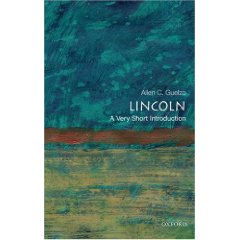 the excerpt from James M. McPherson’s Abraham Lincoln, and Craig L. Symonds post on how Lincoln and his leadership are reflected in our current President. In the original piece below Allen Guelzo, author of Lincoln: A Very Short Introduction, answers some FAQs about Lincoln. You can read part one here and part two here.
the excerpt from James M. McPherson’s Abraham Lincoln, and Craig L. Symonds post on how Lincoln and his leadership are reflected in our current President. In the original piece below Allen Guelzo, author of Lincoln: A Very Short Introduction, answers some FAQs about Lincoln. You can read part one here and part two here.
OUPblog: More than one observer has noted that the Emancipation Proclamation didn’t free any enslaved people in the very territory controlled by Lincoln’s government. What then is its lasting importance?
Allen Guelzo: This is probably the most-frequently-repeated howler in American history, and no one who thinks twice about will ever believe they said it.
The question refers to an apparent oddity in the Emancipation Proclamation – Lincoln freed the slaves in the Confederate States, but did not free the slaves of the four border states which remained loyal to the Union or the slaves in the Southern areas which had been re-occupied by federal forces. So, Lincoln frees slaves where he can’t control them, and neglects to free them where he can. Right? Wrong.
We live under a Constitution which does not give Presidents plenary powers to do anything they like. Only in time of war or rebellion does the Constitution even surrender control of the armed forces to the President, and the “war powers” which the Constitution confers on the President are almost the only discretionary powers he has.
It was under the rubric of those “war powers” that Lincoln issued, and could only have issued, an Emancipation Proclamation. And since those four border states, and the occupied districts of the South, were not at war with the United States, or in rebellion against it any more, Lincoln had no “war power” authority to free any slaves there. If he had tried, slaveowners would have made a bee-line for the federal courts. And at the top of the federal judiciary, itching for a chance to strike down emancipation for good, sat Chief Justice Roger Brooke Taney, the author of the infamous Dred Scott decision. Lincoln might have had the military power to free slaves in those places, but not the legal authority.
By the same token, Lincoln declares the slaves of the Confederacy free because, even though he lacks the military power at that moment to enforce his proclamation, he retained the legal authority to do so. Lincoln had never recognized the Confederacy as a valid government. In his eyes, it was an insurrection against the existing forms of constitutional government, and as such, it came directly under the weight of his “war powers.” He might not have been able to enforce the Proclamation at once, but that’s very different from saying he had no authority to free the slaves there. Having the authority, it was only a matter of time and events before the enforcement, in the form of the Union Army, caught up with the authority and liberated the ex-slaves from their masters. Many of those slaves saw the distinction clearly enough that they began running away in droves to the Union lines, where they knew that the Army would at once recognize their freedom. Together, Lincoln and the slaves made the Proclamation in reality what it already was in law. But the reality would never have happened without the law.
At Gettysburg, Lincoln called on the nation to remember the war dead by a re-dedication to “unfinished work.” What is unfinished today? The unfinished work he was talking about at Gettysburg was the war itself, which he realized had to be won if the principle of government of the people was to be vindicated. If there was a sense in which he looked beyond that, it was to the larger goal of bringing opportunity for self-advancement and self-improvement to as many as possible. For Lincoln, the promise of the Declaration (that “proposition” that all men are created equal) was realized best when an open and democratic society gave to everyone the freedom to climb as far as talent and ambition could take them – as he himself had. Frederick Douglass, the black abolitionist, once wrote that Lincoln “was the first great man that I talked with in the United States freely, who in no single instance reminded me of the difference between himself and myself, of the difference of color.” Douglass attributed Lincoln’s lack of racial bias to Lincoln’s sympathy with Douglass’s struggle and the “similarity with which I had fought my way up, we both starting at the lowest round of the ladder.” I confess, having also started on that “lowest round,” that this is what fascinates me most about Lincoln, too.


"My dream is of a place and a time where America will be seen as the last best hope of earth." ~ Abraham Lincoln

Lincoln with his son, Tad, as photographed by Matthew B. Brady (February, 1864)
Our greatest President is 200 years young today.
Wherever he is, he's probably thrilled about who's occupying his former digs at 1600 Pennsylvania Avenue. Lincoln would be especially pleased to see Malia and Sasha living there, since he was the first President to bring his own small children to live in the White House.
Abe was an indulgent parent, who loved to wrestle with his sons. They provided much needed relief from the tensions of the war, sometimes throwing strawberries around at Cabinet meetings, climbing on furniture, and scattering papers.
Strawberries? Hmmm. What else did our 16th President like to eat? He was our tallest at 6'4", so it seems he would have had a large appetite, but most historians disagree.
His usual breakfast was hot coffee and an egg, sometimes with toast. For lunch, perhaps a biscuit, a glass of milk and some fruit. John Hay, one of Lincoln's private secretaries, said, "he ate less than anyone I know," and Lincoln's law partner, Billy Herndon, said, "Abe can sit and think longer without food than any man I ever met."
Mary Todd Lincoln was often exasperated with Lincoln's eating habits. She loved to host levees and set a fine table, but Lincoln was just as happy with fruit salad, perhaps with cheese and crackers, for dinner. It's not that he didn't enjoy food; he was just very often too preoccupied with his duties to remember to eat. Unlike Thomas Jefferson, who was a true gourmand, fascinated by every aspect of food production and preparation, Abe ate to fuel the furnace, and preferred simple fare.
MENU FOR LINCOLN'S INAUGURAL LUNCHEON (March 4, 1861)*
Mock Turtle Soup
Corned Beef and Cabbage
Parsley Potatoes
Blackberry Pie
Coffee
(he planned the menu himself)
Some of his favorites? Apples, eaten out of hand or baked in pies or cakes. Chicken fricasse and oyster stew. He also retained his appetite for the frontier foods he was raised on -- corn dodgers, wild game, eggs, and bacon. Cornbread with honey was a special treat, and he loved sweets in general, especially the gingerbread men cookies from childhood, and the pecan pie procured at a Washington, D.C., bakery.

Mary was quite eccentric, and a certified shop-a-holic.
But there was one special dessert that figured even more prominently in Abe's personal life, and that was Mary Todd Lincoln's Vanilla Almond Cake. As the story goes, she baked this family favorite for him while they were courting, and he pronounced it, "the best in Kentucky." That sealed the deal, and they were marrried a few years later. It is believed the cake remained a staple in the Todd-Lincoln home in Springfield (where Mary did her own cooking because they couldn't afford help), and later when they moved into the White House.
Some cake! There are several modernized versions of Mary's recipe floating around, most requiring lots of egg whites and a cooked syrup frosting. I decided to try the recipe found in Lincoln's Table, by Donna D. McCready (Lincoln's Presentations, 2008), which calls for powdered sugar instead of frosting. It's not overly sweet at all -- more like a nice coffee cake. It's really the perfect way to celebrate Abe's Bicentennial, Presidents' Day and Valentine's Day. But watch out -- someone might fall in love with you!
MARY TODD LINCOLN'S WHITE CAKE
(makes about 12 slices)

1 cup blanched almonds
2 cups granulated sugar
3 cups all purpose flour
3 tsp baking powder
1 cup milk
6 eggs, separated (best when eggs are cold)
1 tsp vanilla extract
Confectioners' sugar
Using a food processor or spice grinder, pulverize almonds until they resemble coarse flour.
Preheat oven to 350 degrees. Grease and flour a Bundt cake pan.
With an electric beater or stand mixer, cream butter and sugar until light yellow in color and fluffy.
Sift flour and baking powder three times. Fold flour mix into creamed butter and sugar, alternating with milk, until well blended. Stir in almonds and beat well.
In a separate bowl, beat egg whites until they have stiff, firm peaks. Beaters must be washed and dried thoroughly before whipping egg whites or they will not stiffen properly. Fold egg whites gently into butter with rubber spatula. Add vanilla extract.
Pour batter into prepared pan and bake for one hour, or until a skewer inserted comes out clean.
Cool for at least 20 minutes before inverting, then allow to cool completely before serving. Sift confectioners' sugar on top.
Check this out:
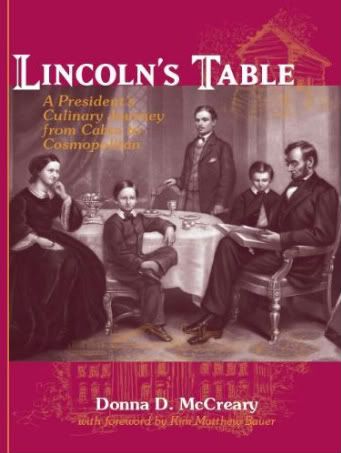
Contains 130 recipes chronicling Lincoln's life from boyhood to Presidency.
What foods shaped our greatest President?
More more more:
If you'd like to try the Vanilla Almond Cake recipe with frosting, click here.
*President Obama's Inaugural Luncheon Menu was created to honor Lincoln and his culinary preferences. The recipes for all the dishes served on January 20, 2009, can be found here.
Elaine at Wild Rose Reader has posted an awesome list of books and other resources related to the Lincoln Bicentennial here.
An avalanche of new children's books about Lincoln were published in 2008 and more are still to come in 2009. See some of them here.
Click here to see my Poetry Friday post about Lincoln's favorite poem.
If you're hungry for more mouth watering, fascinating tidbits about Presidents and their favorite foods, click here.
One Final Tasty Tidbit:

photo by Bron Marshall
*One of our earliest recipes for jelly roll, or jelly cake (sometimes called Lincoln Log), came from Laura Keene, an actress performing in Our American Cousin at Ford's Theatre the night Lincoln was shot. It was published in The American House Wife Cook Book, by T.S. Shute (1878).

 Lincoln Shot: A President's Life Remembered
Lincoln Shot: A President's Life Remembered - A fabulous large format non-fiction picture book that is presented in the form of a mid 1800's newspaper.
and, though this is not a new book:
Many people all around the world are celebrating these birthdays in unique ways. Enjoy remembering the lives of these two men who gave so much to do what they thought was right.

By: Rebecca,
on 2/11/2009
Blog:
OUPblog
(
Login to Add to MyJacketFlap)
JacketFlap tags:
Abraham Lincoln,
Bicentennial,
civil right,
Politics,
fail,
civil war,
Obama,
American History,
A-Featured,
Add a tag
All week on the OUPblog we will be celebrating the Lincoln Bicentennial. Be sure to check in daily for original posts from Allen  C. Guelzo, author of Lincoln: A Very Short Introduction and Craig L. Symonds, author of Lincoln and His Admirals. Also click through and read the posts that have already gone live by Guelzo and an excerpt from Abraham Lincoln by James M. McPherson. Jennifer Weber, author of Copperheads: The Rise and Fall of Lincoln’s Opponents in the North, wrote the post below which looks at how Lincoln almost failed.
C. Guelzo, author of Lincoln: A Very Short Introduction and Craig L. Symonds, author of Lincoln and His Admirals. Also click through and read the posts that have already gone live by Guelzo and an excerpt from Abraham Lincoln by James M. McPherson. Jennifer Weber, author of Copperheads: The Rise and Fall of Lincoln’s Opponents in the North, wrote the post below which looks at how Lincoln almost failed.
Abraham Lincoln is in the news a lot these days, and justifiably so. This year marks the bicentennial of his birth. That would have gotten a fair amount of attention under any circumstances, but the event has attracted even more interest because of the recent inauguration of another tall, lanky, up-by-his-own-bootstraps son of Illinois. Barack Obama, whom some see as a sort of heir to Lincoln, is, at the very least, the logical consequence of Lincoln’s actions. No Lincoln – no emancipation, no black troops, no civil rights (or at least an early promise thereof) – no Obama, at least not now.
In this season of Lincoln celebrations, in the avalanche of new books on our 16th president, it is easy to lapse into unquestioning adoration. From the moment John Wilkes Booth shot him on Good Friday, Lincoln became the American Jesus.
The truth is that, for the first four years of his presidency, Lincoln was a deeply controversial figure. He did not receive a single electoral vote from the South in 1860, and even after the war began many people in the North thought his actions, such as suspending habeas corpus and emancipation itself, were those of a tyrant.
But it was the losses that nearly did Lincoln in politically. The summer of 1864 was grim in a way that Americans today can hardly imagine. Ulysses S. Grant alone had taken 64,000 casualties in a little over a month of the Overland Campaign. What did he have to show for the bloodletting? A siege outside of Petersburg, Virginia. William T. Sherman was stalled on the outskirts of Atlanta, another siege. Nathaniel Banks had made an effort of going into Texas, but got turned back at Shreveport, Louisiana, in the spring and spent the summer sitting on his hands in New Orleans.
Many Northerners were screaming for an end to the war. Democrats who had long supported Lincoln’s actions abandoned him for the antiwar wing of their party. Even Republicans abandoned him. By August 1864 – a mere eight months before his death and martyrdom – the nation’s leading Republicans were certain that their candidate could not win re-election in November. Lincoln himself was resigned to losing. Under tremendous pressure to abandon emancipation as a war aim, Lincoln refused to reneg on his promise to the slaves. He would be “damned in time and eternity” if he did, he explained. He would go down with his principles intact.
Lincoln’s re-election was sealed with Sherman’s victory in Atlanta at the very beginning of September. Public opinion made a complete turnabout with that single event. Northerners were convinced that victory was theirs, and the rest of the war would be a mop-up operation. The national change of heart is startling in its totality, speed, and conviction, even from this distance.
But let’s say that Atlanta did not fall until after the election, and that Phil Sheridan, another Union general, did not stage his romp through the Shenandoah Valley later in September. Lincoln would surely have gone down to defeat. The first thing his opponent, the former general George B. McClellan, would have done would be to jettison emancipation as a condition of war. I believe he would not have had the stomach to continue to prosecute the war, just as he had no stomach to wage it as head of the Army of the Potomac, and he would have given the Confederates their independence. Historians would regard Lincoln, the same man many of them consider the greatest American president, as a failed president.
Lincoln’s enshrinement is testimony to the contingent nature of history. Sherman did take Atlanta before the election, and Sheridan did strip the valley bare, also before the election. Lincoln’s re-election guaranteed that the war would continue to the point of unconditional surrender. His assassination came just days after Robert E. Lee’s surrender. His death, by any measure, is one of history’s greatest tragedies, but it also froze Lincoln in time – and in marble. He did not have to deal with the bulk of Reconstruction, which was sure to be messy even for someone with Lincoln’s great political gifts. Instead, he died at the moment of his triumph, his reputation immediately sealed as the nation’s greatest president. One has to look no further for his legacy than 1600 Pennsylvania Avenue.

By: Rebecca,
on 2/10/2009
Blog:
OUPblog
(
Login to Add to MyJacketFlap)
JacketFlap tags:
Biography,
American History,
A-Featured,
A-Editor's Picks,
Abraham Lincoln,
Bicentennial,
James McPherson,
Sarah Bush Johnston,
Thomas Lincoln,
Add a tag
All week on the OUPblog we will be celebrating the Lincoln Bicentennial. Be sure to check in daily for original posts 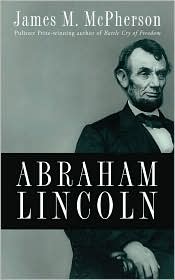 from Allen C. Guelzo, author of Lincoln: A Very Short Introduction, Jennifer Weber, author of Copperheads: The Rise and Fall of Lincoln’s Opponents in the North, and Craig L. Symonds, author of Lincoln and His Admirals. To start things off we have excerpted from Abraham Lincoln by James M. McPherson. This short book is the perfect biography to kickstart our Lincoln celebrations. The excerpt below begins with Lincoln’s birth, on February 12, 1809.
from Allen C. Guelzo, author of Lincoln: A Very Short Introduction, Jennifer Weber, author of Copperheads: The Rise and Fall of Lincoln’s Opponents in the North, and Craig L. Symonds, author of Lincoln and His Admirals. To start things off we have excerpted from Abraham Lincoln by James M. McPherson. This short book is the perfect biography to kickstart our Lincoln celebrations. The excerpt below begins with Lincoln’s birth, on February 12, 1809.
Abraham Lincoln was born on February 12, 1809, in Hardin County, Kentucky, about fifty miles south of Louisville. His father, Thomas Lincoln, had come as a child with his family from Virginia in 1782. Thomas acquired only enough literacy to sign his name but gained modest prosperity as a carpenter and farmer on the Kentucky frontier. He married Nancy Hanks, also illiterate, in 1806. Abraham was born in a log cabin on Sinking Spring Farm three miles south of Hodgenville. When he was two years old the family moved to another farm on Knob Creek about seven miles northeast of Hodgenville. On this farm of 230 acres (only thirty of which were tillable), young Abraham lived for five years, helped his parents with chores, and learned his ABCs by attending school for a few weeks with his older sister, Sarah.
In December 1816 the Lincolns moved again, this time to Indiana, which had just been admitted to the Union as a state. The traditional notion that the Lincolns moved because of a dislike of slavery may have some truth; they belonged to a Baptist denomination that broke from the parent church on the slavery issue. The main reason for the move, however, was the uncertainty of the land titles in Kentucky, which caused Thomas to lose much of his property. Indiana offered secure titles surveyed under the Northwest Ordinance. There Abraham learned the use of axe and plow as he helped his father carve a house and farm out of the hardwood forest. The growing youth also snatched a few more months of education in the typical one-room schoolhouses of the frontier. In late 1817 or early 1818 the Lincolns were joined by Nancy’s aunt Elizabeth Hanks Sparrow and her husband, Thomas Sparrow, and Abraham’s cousin Dennis Hanks. Soon thereafter, in the fall of 1818 the Sparrows and Nancy Hanks Lincoln all died of “milk sick,” probably caused by drinking the milk of cows that had grazed on poisonous white snakeroot.
After a year of trying to keep house and raise the children by himself, Thomas Lincoln returned to Kentucky to seek a wife. On December 2, 1819, he married the widow Sarah Bush Johnston and brought her and her three children to his farm on Pigeon Creek, Indiana. His stepmother provided Abraham with affection and guidance. With a desire for learning and an ambition for self-improvement, he devoured every book he could borrow from the meager libraries of friends and neighbors. The King James Bible and Pilgrim’s Progress offered him maxims for life as well as a model for the poetic prose that characterized the best of his later writings. Thomas Lincoln neither encouraged nor understood his son’s intellectual ambition; quite the contrary, he chastised Abraham’s “lazy” preference for the reading over working.
The teenaged Abraham’s thinly veiled disdain for life of a backwoods farmer doubtless irritated his father. Abraham in turn resented the requirement of law and custom that any wages he earned before he reached the age of twenty-one—by hiring out to neighbors to split rails, for example—must be turned over to his father. Abraham Lincoln’s hatred of slavery, which denied to slaves the “fruits of their labor,” may have been influenced by Thomas Lincoln’s expropriation of Abraham’s earnings. In any event, relations between Abraham and his father grew increasingly strained. When Thomas lay dying in January 1851, he sent word that he wanted to say goodbye to his son. Abraham refused to make the eighty-mile trip, stating that “If we could meet now, it is doubtful whether it would not be more painful than pleasant.” He did not attend his father’s funeral.
 Last month I read a lot of books about Abraham Lincoln so that I could update my Abraham Lincoln feature on the Through the Looking Glass Book Review website. One of the books I read was by author Harry Mazer, and it is called My brother Abe. The story is told by Abraham Lincoln's sister, Sally, and it beautifully captures the hardship and difficulties that Abraham Lincoln's family faced.
Last month I read a lot of books about Abraham Lincoln so that I could update my Abraham Lincoln feature on the Through the Looking Glass Book Review website. One of the books I read was by author Harry Mazer, and it is called My brother Abe. The story is told by Abraham Lincoln's sister, Sally, and it beautifully captures the hardship and difficulties that Abraham Lincoln's family faced.
I was so moved by the book that I decided to interview the author:
1. I just read your book My Brother Abe and I enjoyed it enormously. Where did the idea for this book come from? THERE ARE VERY FEW STORIES ABOUT ABE LINCOLN’S EARLIEST YEARS, BUT I REALIZED THERE WERE NONE ABOUT SARAH LINCOLN, HIS OLDER SISTER.
2. Abraham Lincoln’s sister Sally tells the story, often in the vernacular of the times. How did you create this voice for Sally? RESEARCH INTO SPEECH PATTERNS OF THE WEST VIRGINIA MOUNTAIN PEOPLE, CERTAINLY, BUT BASICALLY IMAGINATION.
3. As I understand it there isn’t that much information available about Abraham Lincoln’s early years. Where did you find the material that you used to write this book? I FOUND MUCH OF MY MATERIAL IN HARRIET ARNOW’S THE FLOWERING OF NEW ENGLAND, WHICH IS A KIND OF BASIC TEXT ABOUT THAT WORLD.
4. Writing a book is always hard work. What did you enjoy about writing this particular title? I ENJOYED CREATING THE CHARACTER OF SARAH LINCOLN, WHO WAS A BLANK SLATE.
5. This is very different from your other books in some ways. What do you think makes this book stand out? IN TELLING SALLY’S STORY, I FOUND A WAY TO TELL ABRAHAM LINCOLN’S STORY.
6. Do you find that you put a lot of yourself into your books? I FIND MYSELF IN ALL MY BOOKS.
7. Is there a particular time in history that you would like to write about? I’VE WRITTEN ABOUT CONTEMPORAY SUBJECTS AND HISTORIC SUBJECTS AND HAVE FOUND THEM ALL ABSORBING.
8. Your daughter has also become a successful writer. What is it like to see your child follow in your footsteps? IT FILLS ME WITH PRIDE.
9. You have written several books with your wife? Was it hard to make the shift from writing alone to writing as part of a team? NO. I ENJOYED EVERY BIT OF IT. EVEN WHEN WE FOUGHT, I ENJOYED IT.
10. I know it is awfully hard to choose, but which book did you especially like when you were a young person? MY FAVORITE BOOK OF ALL TIME IS ROBINSON CRUSOE, A SURVIVAL STORY, WHICH IS MY ABIDING SUBJECT.
Thank you so much Harry Mazer for participating in this interview.
From the Lincoln Bicentennial Commission (1809-2009)
From the Lincoln Home National Historic Site
Lincoln Home TourThe Lincoln Home through the YearsLincoln History & Culture Page
From The Lincoln Bicentennial Teacher Network
From C-SPAN
From Reading Rockets: Celebrating Abraham Lincoln’s 200th Year (Suggested Children’s Books)
From Scholastic: Celebrate Lincoln’s Bicentennial
Lincoln and Poetry
 Guest blogger Tina Chovanec is the manager of Reading Rockets.org: the authoritative online source for comprehensive and accessible information about teaching young children to read and helping those who struggle. Reading Rockets is one of four multimedia educational websites created by Learning Media, a division of WETA, the PBS affiliate in the Washington DC area.
Guest blogger Tina Chovanec is the manager of Reading Rockets.org: the authoritative online source for comprehensive and accessible information about teaching young children to read and helping those who struggle. Reading Rockets is one of four multimedia educational websites created by Learning Media, a division of WETA, the PBS affiliate in the Washington DC area.
Long before my two young daughters understood the significance of the Emancipation Proclamation or could recognize the beautiful words of the Gettysburg Address, they could zing you with a line from The Abraham Lincoln Joke Book:
“If I were two-faced, would I be wearing this one?”
Their first impression of our 16th president is that he was funny. And with a little text deconstruction from Mom and Dad, they discovered that Lincoln was also a person of modesty and integrity.
Lincoln’s official photographs reveal a man of quiet intelligence, with little hint of his “acute sense of the ridiculous.” But Lincoln was droll and personable in real-life, well-known for his animated telling of jokes old and new. Considered a master storyteller, he used stories as metaphors to convey some universal wisdom, or simply to lift the spirits of those around him during dark times.
“The things I want to know are in books; my best friend is the man who’ll get me a book I have not read.”
Lincoln was a hungry reader. Too poor to own any books, he would walk miles to borrow from whoever would loan them. Aesop’s Fables, The Arabian Nights, Robinson Crusoe, the Bible, Shakespeare, and the poet Robert Burns were among his favorites.
This month, we celebrate the 200th year of the birth of Abraham Lincoln, and it just seems fitting to honor his extraordinary life through stories and books. Visit the children’s section of your public library or local bookstore and you’ll see shelves bursting with wonderful books that give children an intimate look at Lincoln as a young boy, a husband, and a father. Here are three NEW books worth reading with the kids in your life:
- The Lincolns: A Scrapbook Look at Abraham and Mary (by Candace Fleming)
This “scrapbook” history uses photographs, letters, engravings, political cartoons, and clippings to invite you into the real lives of Abraham and Mary Todd Lincoln. In this video interview, discover how author Candace Fleming created a personal, nontraditional history of the Lincolns.
- Lincoln and His Boys (by Rosemary Wells)
A tender portrait of Abraham Lincoln told through the eyes of his sons, Tad and Willie. In this video interview, find out about author Rosemary Wells’ approach to writing historical fiction.
So, make haste to your public library, school library, bookstore, or book swap—and start reading!
“Things may come to those who wait, but only the things left by those who hustle.”
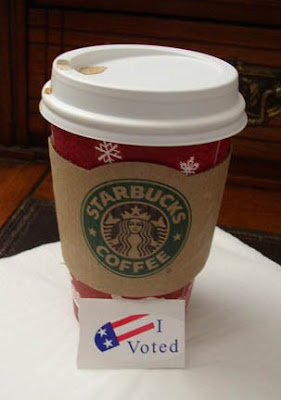
I cast my ballot then headed over to Starbucks for my free cup of coffee (if you showed your "I Voted" sticker they gave you a free cup). That was a pretty cool thing to do. They didn't even ask who you voted for. Now that's Democratic.
Driving home there was this amazingly wonderful sky. Its been raining, but today it cleared up and there are these picture-perfect huge fluffy clouds just hanging there against a gorgeous cerulean blue background.
And on the radio was James Earl Jones doing an Abraham Lincoln recitation with Aaron Copeland music in the background. It was all just too moving and stirring and wonderful and I actually felt a little leap in my heart, like it was a sign of new better things ahead.
I also had some new illustration work come in today, which felt good.
Blue skies ahead? Let's hope so.
Google's banner for today. Fun.
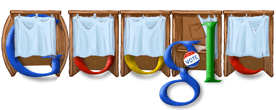
























A Lincoln biography for the younger student:
The Life of Abraham Lincoln for Young People, by Harriet Putnam
An illustrated biography of Abraham Lincoln written especially for young students, and young readers.
The book is written in one-syllable words; every word is broken into it's individual syllables.
I remember my brother used the children's book Abe's Honest Words in one of his research papers.